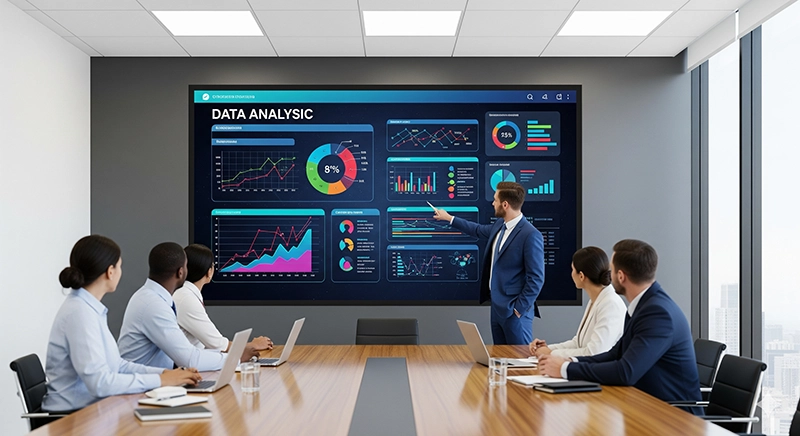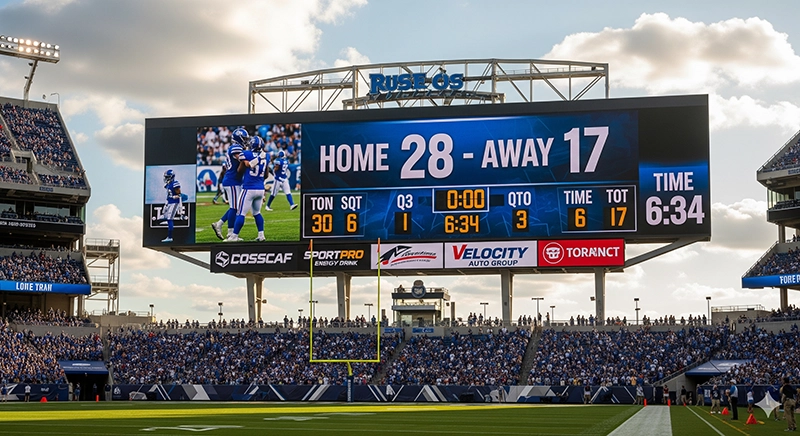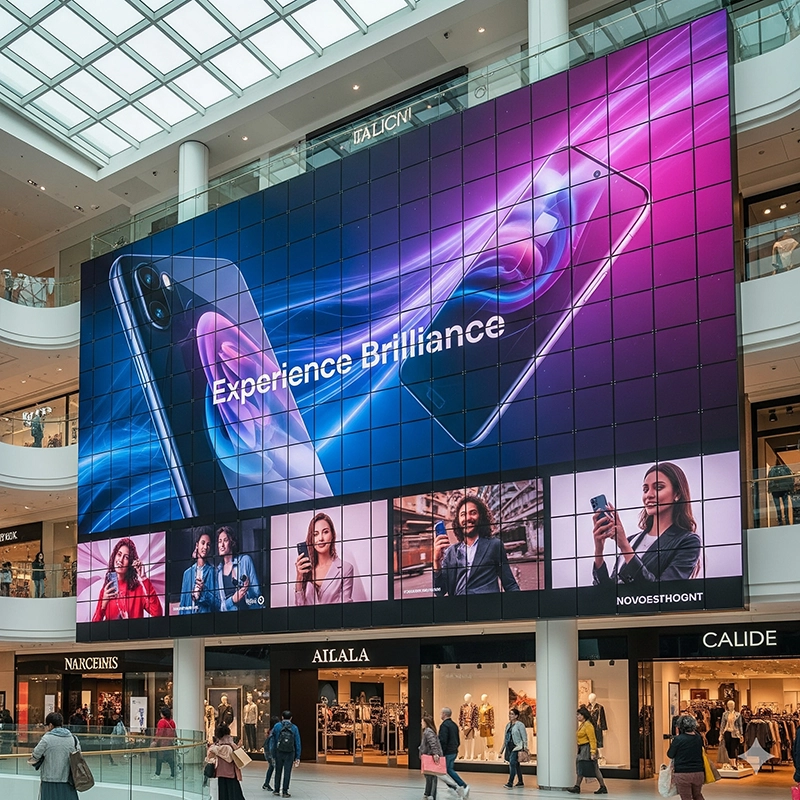A led display is a large video wall system made of light-emitting diodes that form images, videos, and text. Choosing the right pixel pitch is crucial because it determines the clarity of the image, the appropriate viewing distance, and the cost of the installation. Indoor led displays require finer pixel pitch for close viewing, while outdoor led displays typically use larger pixel pitches to cover wide areas and distant audiences. Indoor and outdoor applications differ greatly, so understanding pixel pitch is the first step in selecting the right led display.
Pixel pitch is the distance in millimeters between two adjacent pixels on a led display. It is usually labeled as P1.5, P2.5, P6, or P10, where the number indicates millimeters between pixels. The smaller the pixel pitch, the higher the pixel density and resolution.
Fine pitch led displays (P1.2–P2.5) are ideal for conference rooms, retail stores, and museums where audiences stand close to the screen.
Medium pitch led displays (P3–P6) balance cost and clarity, working well in auditoriums and sports halls.
Large pitch led displays (P8–P16) are suited for outdoor billboards, stadiums, and highways where viewers watch from a distance.
Pixel pitch is often linked to viewing distance, resolution, and cost. The closer the audience, the finer the pitch required. A simple rule is one meter of viewing distance equals one millimeter of pixel pitch. This triangle of distance–clarity–budget guides every decision for led display projects.
Indoor led displays are used in corporate lobbies, shopping malls, churches, exhibition halls, and command centers. Since viewers are often within a few meters of the screen, image clarity is critical.
Typical indoor pixel pitch: P1.2–P3.9.
P1.2–P1.5: Ultra-fine pitch for high-end applications such as control rooms, broadcast studios, and luxury showrooms.
P2.0–P2.5: Balanced option for malls, conference halls, and education spaces, providing clear visuals at moderate cost.
P3.0–P3.9: Cost-effective choice for large rooms, auditoriums, and theaters where audiences sit further away.
Audience proximity: Closer seating requires finer pixel pitch.
Content type: Presentations and text-heavy content need sharp resolution.
Screen size: Larger displays can tolerate slightly larger pixel pitches without losing clarity.
Lighting environment: Indoor led displays rely more on resolution than brightness since lighting is controlled.
For example, a museum installing an interactive digital wall will benefit from P1.5 fine pitch led displays because visitors stand less than two meters away. By contrast, a university lecture hall can achieve excellent results with P3.0, since students usually sit more than six meters from the screen. Most buyers find P1.5 to P2.5 indoor led displays to be the ideal balance between sharpness and budget.
Unlike indoor environments, outdoor led displays must prioritize brightness and durability over ultra-fine resolution. These displays are installed in public spaces such as stadiums, highways, shopping districts, and building facades. Clarity matters, but the audience is usually far enough that ultra-fine pitch is unnecessary.
Typical outdoor pixel pitch: P4–P16.
P4–P6: Perfect for stadium scoreboards, shopping streets, and transport hubs with viewing distances under 20 meters.
P8–P10: Common choice for plazas, highways, and large sports arenas, viewable from 15–30 meters.
P12–P16: Standard for massive billboards on highways or rooftops where audiences watch from 30 meters or more.
Viewing distance: Audiences are farther away, making larger pitch more economical.
Brightness: Outdoor led displays require 5000–8000 nits to remain visible in direct sunlight.
Durability: Screens must resist water, dust, wind, and temperature changes.
Cost efficiency: Larger pitch drastically reduces price per square meter, essential for giant billboards.
For instance, a shopping district advertising screen may use P6, ensuring both brightness and clarity for pedestrians at 10–15 meters. In contrast, a highway billboard performs well with P16, since cars pass at speed and long distances make fine detail unnecessary.
| Application | Pixel Pitch Range | Viewing Distance | Key Features |
| Indoor retail shop | P1.5–P2.5 | 2–5 m | High detail, sharp text and graphics |
| Indoor control room | P1.2–P1.8 | 1–3 m | Precision clarity, fine pitch display |
| Outdoor sports arena | P6–P10 | 15–30 m | Bright, durable, large-scale visuals |
| Outdoor billboard | P10–P16 | 30+ m | Cost-effective, wide audience reach |
This comparison makes it clear that environment defines the pitch: clarity and resolution for indoor led displays, brightness and scale for outdoor led displays.
After understanding indoor and outdoor differences, the next step is making a practical choice for your own project.
Step 1: Define the closest and farthest viewing distance.
Step 2: Match display size with pixel pitch for balance between cost and clarity.
Step 3: Decide based on content: data-heavy visuals require fine pitch, advertising may not.
Step 4: Assess environmental needs: indoor focuses on clarity, outdoor focuses on durability and brightness.
Step 5: Consider long-term use: a fine pitch led display may serve multipurpose venues better.
For example, a company that uses a display for both corporate presentations and product launches may invest in P2.0, knowing it supports detailed text as well as video. Meanwhile, a sports stadium might select P8, balancing budget with visibility for large crowds.
After technical selection, cost remains the deciding factor for many buyers. Pixel pitch is the biggest factor influencing price. Smaller pitch means more LEDs per square meter, which drives up cost.
A P1.5 led display can cost up to three times more than a P4 screen of the same size.
For large-scale outdoor installations, P10 or P16 dramatically reduces costs while maintaining visibility.
Energy consumption is slightly higher for fine pitch led displays, but modern technology has improved efficiency.
ROI depends on context: luxury showrooms may justify P1.5, while highway billboards achieve better ROI at P10 or above.
The right choice balances image quality with business goals. Buyers should avoid overspending on ultra-fine pitch when their audience cannot benefit from it,A Statista 2025 forecast indicates that outdoor LED billboards will account for nearly 45% of the digital out-of-home advertising market worldwide, reflecting the cost efficiency and broad audience reach of large pitch LED displays in commercial advertising.
Indoor led displays work best with P1.2–P2.5 for premium quality, or P3–P3.9 for larger venues.
Outdoor led displays should use P4–P6 for closer crowds, P8–P10 for stadiums and plazas, and P12–P16 for long-distance billboards.
Always match viewing distance with pixel pitch and adjust for budget.
Brightness, durability, and cost are equally critical for outdoor environments.
Research from IEEE further confirms that advancements in microLED and energy-efficient technologies will reduce power consumption of large-format led displays by up to 30% over the next five years, ensuring long-term sustainability for both indoor and outdoor installations.By aligning viewing distance, pixel pitch, and budget, businesses can ensure their led display investment delivers long-term value, engaging audiences effectively whether in a retail store, a corporate lobby, a stadium, or on a city street.
Led displays are no longer limited to advertising or entertainment. Their versatility has made them an essential tool across a wide range of industries. In the retail sector, led displays attract customers with dynamic storefront visuals and real-time promotions. In education, universities and training centers use fine pitch led displays to deliver interactive learning experiences and visual-rich lectures. Healthcare institutions employ led video walls in waiting areas to provide patient information and awareness campaigns. In transportation, airports and metro stations rely on led displays for flight schedules, passenger information, and public safety messages. Each of these applications highlights how adaptable led displays are when configured with the right pixel pitch and design.
According to LEDinside’s 2024 industry report, the global LED display market size exceeded USD 8.5 billion and is projected to grow at a CAGR of over 6% through 2027, driven by demand for fine pitch LED displays in corporate and retail applications.The led display market continues to evolve with innovations that improve performance and efficiency. MicroLED technology is pushing pixel density to new levels, offering ultra-fine resolutions that rival traditional LCDs. Energy-efficient led displays are gaining popularity, lowering operational costs for large installations. Transparent led displays are being introduced in retail and architectural design, allowing brands to merge digital visuals with physical environments. Flexible and curved led displays are also becoming more common, creating immersive viewing experiences in museums, exhibitions, and creative stage designs. These future trends demonstrate that led displays will continue to expand beyond conventional advertising, transforming the way businesses communicate visually in both indoor and outdoor spaces.
Hot Recommendations
Hot Products
Get a Free Quote Instantly!
Talk to Our Sales Team Now.
If you are interested in our products, please contact us promptly
Reach out to our sales team to explore customized solutions that perfectly meet your business needs and address any questions you may have.
Email Address:info@reissopto.comFactory Address:Building 6, Huike Flat Panel Display Industrial Park, No. 1, Gongye 2nd Road, Shiyan Shilong Community, Bao'an District, Shenzhen city , China
whatsapp:+8615217757270